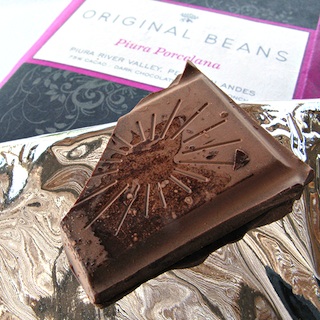 The world of fine chocolate has seen some major change in the past few years, much of it focused on the rise of so-called “bean to bar” chocolate made by smallish producers with an eye on the distinctive qualities of different cacao beans. One company that’s been making a name for itself is Original Beans, which markets a package that tells “The story of cacao in four bars” that recently won a silver medal for packaging at the Academy of Chocolate awards in London. Last summer, I was lucky enough to sit down with Sudi Pigott, a consultant to Original Beans, and taste a couple of them.
The world of fine chocolate has seen some major change in the past few years, much of it focused on the rise of so-called “bean to bar” chocolate made by smallish producers with an eye on the distinctive qualities of different cacao beans. One company that’s been making a name for itself is Original Beans, which markets a package that tells “The story of cacao in four bars” that recently won a silver medal for packaging at the Academy of Chocolate awards in London. Last summer, I was lucky enough to sit down with Sudi Pigott, a consultant to Original Beans, and taste a couple of them.
Podcast: Play in new window | Download (Duration: 10:53 — 5.5MB)
Subscribe: Google Podcasts | Spotify | Android | | More
I came away from the interview with half a bar of one we didn’t taste, the Piura Porcelana. Typing the ID code into the Original Beans website took me lickety split to a page all about that chocolate. It’s an intriguing story, the Porcelana variety being characterised by beans that are a lot lighter in colour than most cacao. Porcelana, of which there are said to be 33 genetically different types, was apparently rediscovered by Original Beans in 2007, since when the company has been working with local farmers and NGOs to boost production. But there are some niggles too. It’s strange, for example, to be told:
The Piura Porcelana’s origin is located on the foothills of a mountain range reaching above 2000 meters, called the Sierra Piura. The area is part of the xxx biodiversity hotspot, with bears etc. . Much of the original forest has been cut down over the past decades, resulting in changing weather and water supply. Now it is being replanted and restored.
xxx biodiversity hotspot? Bears etc? Is somebody still doing fact-checking and research for the copy?
Original Beans is good chocolate, no doubt about that, although there’s also been a bit of a to-do in the rarefied world of chocosnobs about who exactly makes Original Beans’ chocolate. The packaging says Made in Switzerland, although the company is headquartered in Amsterdam. CEO and founder Phillip Kauffmann is quite open about it being made by Felchlin, at least when asked, but that information is not widely available. Is that a problem? Not to me. There are people who make chocolate, and people who make things from chocolate, and they’re often not the same people. Apparently at the fine end of the “beans to bar” world that matters. Original Beans does everything except make the bars; I think that’s acceptable.
Is the price equally acceptable? I don’t know; what should good chocolate cost? Fair prices for farmers, men and women alike, no child labour, environmental sustainability, conservation, all that … what’s it worth?
I’m not the first to ask the question What Is The True Cost of Chocolate? of Original Beans, and the answers given then, in 2009, certainly have a lot of feelgood about them. In truth, though, I don’t think we’re any nearer an answer, and we won’t be until we have independent audits and much more transparency than most businesses could survive. There’s a real dilemma here. Original Beans and many other topnotch chocolate makers can charge what they do in large part because they are making smaller batches. They’re competing with one another, not with the industrial giants. Industrial chocolate really is a rather ghastly business in all sorts of ways, and yet I don’t see the vast majority of its customers switching to more ethical products, and if they did, I don’t see the ethics surviving the onslaught.
Notes
- Original Beans’ local partner in Peru made a video about Piura Porcelana.
- Here’s another video, of Original Beans’ Phillip Kauffmann talking about Cru Virunga.
- Most of the world’s chocolate is now grown in Africa, away from the pests and diseases of its home in Latin America. Here’s a long article about its first home in Africa, São Tomé and Príncipe.
- Oxfam has been running a campaign to persuade industrial chocolate to do better; it may be starting to bite.
- Intro music by Dan-O at DanoSongs.com.
- Final music by Cécile Kayirebwa. No idea which track; it just started playing when I reached her site, and for once I am glad for autoplay.
Engage
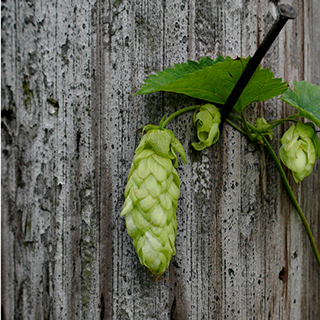 Perhaps you saw an article in a recent BBC News magazine about how US craft beer is inspiring British brewers. The Americans say they’re not bound by tradition, with the clear implication that the Brits are. And yet it was insipid American beers — like making love in a canoe, we used to say — that triggered the rise of microbreweries and craft beers. Now very hoppy beers with all kinds of flavours are big there, and increasingly big in the UK, and one result has been a resurgence of interest in British-bred hops. One of these, OZ97a, is being hailed as a new star of British brewing, not least by Mark Dredge, an award-winning beer writer. I read about OZ97a at Pencil and Spoon, Mark’s blog. Of course I had to talk to him.
Perhaps you saw an article in a recent BBC News magazine about how US craft beer is inspiring British brewers. The Americans say they’re not bound by tradition, with the clear implication that the Brits are. And yet it was insipid American beers — like making love in a canoe, we used to say — that triggered the rise of microbreweries and craft beers. Now very hoppy beers with all kinds of flavours are big there, and increasingly big in the UK, and one result has been a resurgence of interest in British-bred hops. One of these, OZ97a, is being hailed as a new star of British brewing, not least by Mark Dredge, an award-winning beer writer. I read about OZ97a at Pencil and Spoon, Mark’s blog. Of course I had to talk to him. The world of fine chocolate has seen some major change in the past few years, much of it focused on the rise of so-called
The world of fine chocolate has seen some major change in the past few years, much of it focused on the rise of so-called 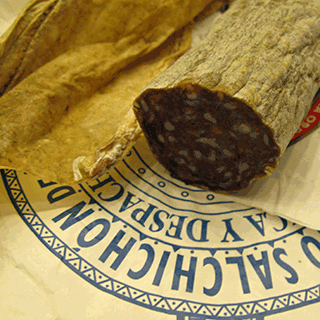 Among the more miraculous edible transformations is the one that turns raw meat, salt and a few basic spices into some of the most delicious foods around.
Among the more miraculous edible transformations is the one that turns raw meat, salt and a few basic spices into some of the most delicious foods around.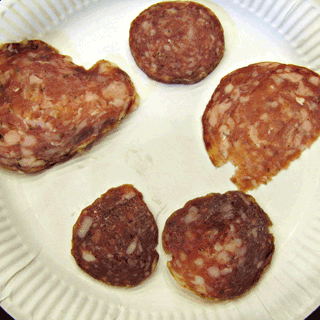
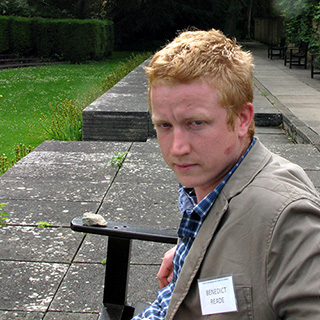 Peat diggers in Ireland and elsewhere have occasionally unearthed objects, usually made of wood, that contained some kind of greasy, fatty material with a “distinctive, pungent and slightly offensive smell”.
Peat diggers in Ireland and elsewhere have occasionally unearthed objects, usually made of wood, that contained some kind of greasy, fatty material with a “distinctive, pungent and slightly offensive smell”.